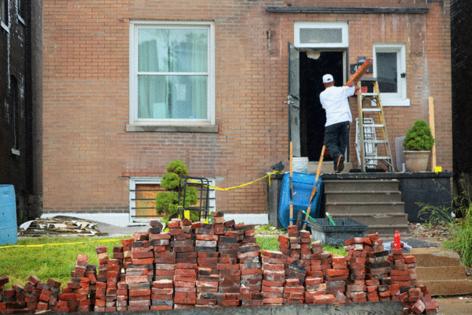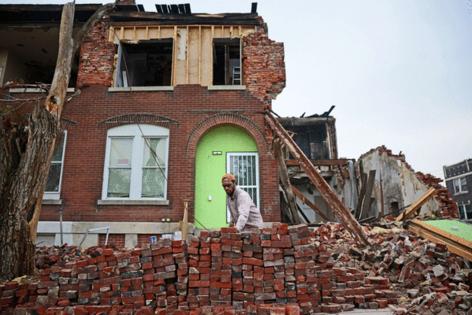St. Louis was a brick 'epicenter.' Can it keep its bricks after the tornado?
Published in Home and Consumer News
ST. LOUIS — Beyond immediate needs tied to shelter and safety, preservation experts and local officials say they’ve heard a common refrain in the aftermath of last month’s deadly tornado that ravaged parts of St. Louis, bringing down multiple brick structures:
What’s going to become of all that brick from damaged buildings — and how can the city save the material that’s a distinct symbol of St. Louis pride and identity from landfills and potential larceny?
“We’re one of the few truly brick cities in the country,” said Alderman Michael Browning of the 9th Ward. “It speaks to the character of the city. That’s a character we want to preserve.”
On May 16 an EF3 tornado cut across the city from the Central West End and into north St. Louis neighborhoods of historic red brick homes, like Fountain Park, killing five people. Homes and buildings were toppled by the storm, leaving rooms without walls or roofs, and creating mountains of brick, lumber and more.
St. Louis’ strong brick heritage stretches back well over a century — or even to past millennia, in a geological sense. The local abundance of clay provided the material that industrialists like the Hydraulic Press Brick Co. converted into untold volumes of brick, starting in the 1800s.
From its St. Louis hub, the company grew to become the world’s biggest brick producer, and created what “came to be known as the perfect brick” with a red tinge, said Will Quam, a Chicago-based architecture expert who leads brick-related tours, and will visit St. Louis to give a talk about bricks later this month.
“When you think of this platonic ideal of a brick, you’re picturing a brick made in St. Louis by the Hydraulic Press Brick Co.,” he said. “St. Louis was the real epicenter of brick fashion in the late 19th century.”
Bricks can take on different hues and characteristics, based on local geology where their clay is harvested. For example, bricks from Chicago and Milwaukee are distinctly lighter in color than those made here.
Today, the glory and grit of St. Louis brick has made the material a target that can fetch premium prices, and is coveted by salvagers, brickyards, brazen thieves and, eventually, builders even out of state.
“People love the look of an old brick and they will pay good money for it,” Quam said. “They want the look of a brick that has weathered for 100 years as opposed to a modern brick that is maybe too perfect.”
He said that around Chicago, reclaimed St. Louis bricks are selling for $1.51 each, or $800 for a pallet of 530 bricks. That’s almost 20% more than reclaimed “Chicago Common” bricks, which he said go for $1.25 apiece.
That appeal of St. Louis brick is raising fears that the tornado could accelerate the long-established trend of St. Louis’ salvaged brick leaving town, often for destinations across the southern U.S., where it can commonly be sliced up and used as cladding.
“You have people who will lose their homes and will then lose their brick to some multimillion-dollar development in the South,” said Quam.
In the weeks since the tornado, St. Louis residents, volunteers and workers have begun sifting through jumbled piles of rubble from the damaged buildings that may be condemned and empty or collapsed, sometimes setting aside tidy stacks of bricks.
Residents said they and their neighbors intend to reuse those intact, salvaged bricks to rebuild and repair their homes.
“I haven’t heard anyone say anything about selling their bricks,” said Richard Ellis, a Fountain Park resident who was helping with work at a nearby home on Thursday night. “That has not even been a discussion.”
Tornado victims ponder reuse of fallen bricks
Bricks from the family home of Gale Davis on Labadie Avenue sit neatly in a pile on Wednesday, June 4, 2025, as a family member carries lumber inside for repairs. Davis and her family plan to repair their damaged facade with the bricks they’ve salvaged from the May 16 tornado that left the house without a roof.
A hallmark brick city
St. Louis brick is a valued piece of local history, geology and architectural flavor. Even before the tornado struck, city officials were talking about how to protect it.
“People aren’t stupid — they do value it,” said Michael Allen, a history professor at West Virginia University who, until last year, was a lecturer on architectural history at Washington University. “They just might not value the building it comes from as much as the commodity it generates when it’s demolished.”
But not all St. Louis brick has the same appeal. Salvagers are generally looking for bricks made in a “sweet spot” from about 1900 to the 1930s, said Kyle Lansing, a local salvager and preservation specialist. Before that, he said, bricks were often hand-pressed.
“This summer’s gonna be full, just in north city,” said Lansing. “There’s so much stuff up there that should be saved that I hope to be a part of.”
Another challenge comes from the limited capacity of salvage workers compared to the scale of regional storm damage, and the slower pace of reclamation work, which is done by hand.
“A lot of those buildings are still going to be standing in six to eight months,” said Allen. “I think there’s time to do something at scale. It doesn’t have to be done all at once.”
Some of the homes, church buildings and businesses the tornado fully or partially toppled have been in families or congregations for decades. Others are city-owned, leading some aldermen in hard-hit wards to question the typical practice of hiring local demolition contractors who work at a discounted price, in exchange for the right to resell bricks or other salvageable materials.
The officials wonder if it could be a better deal for the city to pay more for demolition work, while getting to keep the brick, instead — especially when the material could be used in rebuilding efforts.
“What is the greater cost?” asked Alderwoman Laura Keys of the city’s 11th Ward, who said she discussed the matter with the mayor’s office on May 13, three days before the tornado. “Would it be better for us as a city in the long run to go ahead and pay them outright … and take custody of those bricks?”
Alderwoman Sharon Tyus of the 12th Ward agreed that a change should be explored to prevent further exports of the city’s bricks, especially with salvage work set to unfold “at such a large scale,” she said.
“I would love to see that stop happening and that we would save them and keep them in the neighborhood,” Tyus said. “I would love to see the brick taken back and kept in St. Louis.”
Demolition and salvaging isn’t the only way valuable bricks leave neighborhoods — theft has long been a concern, especially from vacant buildings. Tyus, for instance, said that several years ago, she watched a “whole garage be stolen, brick by brick,” in her neighborhood.
Brick generally represents the most valuable material that can be salvaged from a demolished home, experts said.
“In the midst of recovery, thieves can often blend in and look like contractors,” said Allen, the professor. “Who’s going to second guess, in the moment?”
Rumors of recent brick thefts in tornado-damaged areas have been circulating, city officials and residents say, but St. Louis police spokesman Mitch McCoy said Saturday the department isn’t aware of any reports being filed.
To help retain and protect more of the city’s brick, Keys, Tyus and others hope to see the material funneled toward a “brick bank” repository that local residents could draw from during future construction or restoration efforts. Residents and the city could store their bricks at a secure location, saving them to use on their own rebuilds, or share with others.
And although brick banking is a relatively untested concept, St. Louis could be as good a place as any for it to take root, Allen said.
“St. Louis, being kind of a hallmark brick city, might be a place to start,” he said. “It’s a great chance to test the viability of that idea.”
If nothing is done, he said, current trends suggest that the material will likely end up in places like Florida or the Southwest.
“You’ll see it in Phoenix, Arizona, or the suburbs of Orlando,” he said. “It’s sad for St. Louis.”
©2025 STLtoday.com. Distributed by Tribune Content Agency, LLC.











Comments